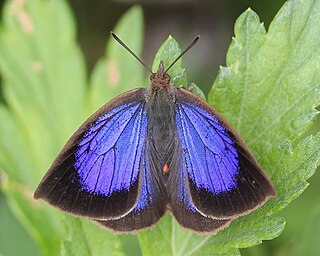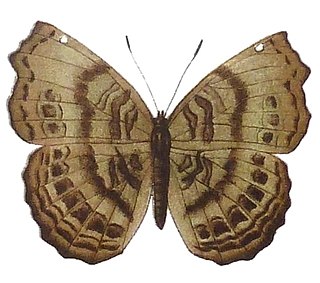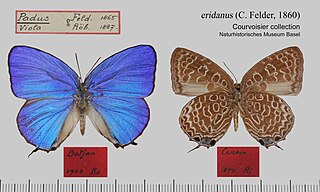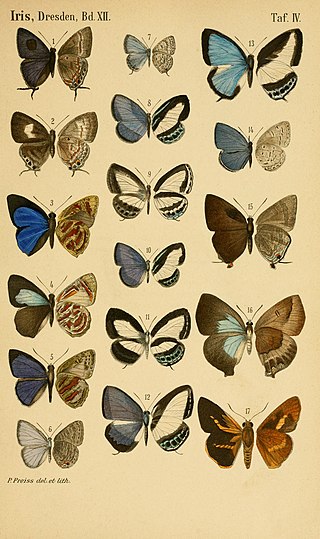
Arhopala is a very large genus of gossamer-winged butterflies (Lycaenidae). They are the type genus of the tribe Arhopalini. In the relatively wide circumscription used here, it contains over 200 species collectively known as oakblues. They occur from Japan throughout temperate to tropical Asia south and east of the Himalayas to Australia and the Solomon Islands of Melanesia. Like many of their relatives, their caterpillars are attended and protected by ants (myrmecophily). Sexual dichromatism is often prominent in adult oakblues.

Danis is a genus of butterflies in the family Lycaenidae. The species of this genus are found in the Australasian realm.

Hypochrysops is a genus of butterflies in the family Lycaenidae first described by Cajetan Felder and Rudolf Felder in 1860. This particular genus is exclusive to the Australian area with only a few species straying into Papua New Guinea.

Carl Heinrich Michael Ribbe was a German explorer and entomologist.

Arhopala madytus, the bright oakblue, is a butterfly of the family Lycaenidae. The species was first described by Hans Fruhstorfer in 1914. It is found on New Guinea and adjacent islands and the north-east coast of Queensland, Australia.

Arhopala micale, the common oakblue or shining oakblue, is a butterfly of the family Lycaenidae. The species comprises about 16 subspecies, which are found in Melanesia and New Guinea as well as the north coast of Australia.

Ariadne pagenstecheri, the Pagenstecher's castor or scalloped castor, is a butterfly in the family Nymphalidae. It is found in Nigeria, Cameroon, the Central African Republic, southern Sudan, Uganda, Rwanda, Burundi, western Kenya, north-western Tanzania and the eastern and central parts of the Democratic Republic of the Congo. The habitat consists of the margins of sub-montane and montane forests.

Arhopala zambra, the Zambra oakblue, is a species of butterfly belonging to the lycaenid family described by Charles Swinhoe in 1911. It is found in Southeast Asia.

Arhopala chamaeleona is a butterfly in the family Lycaenidae. It was described by George Thomas Bethune-Baker in 1903. It is found in the Indomalayan and Australasian realms.

Arhopala eridanus is a butterfly in the family Lycaenidae. It was described by Cajetan Felder in 1860. It is found in the Indomalayan realm.
Arhopala tindali is a butterfly in the family Lycaenidae. It was described by Carl Ribbe in 1899. It is found on the Solomon Islands and New Britain.

Hypochrysops pagenstecheri is a butterfly of the family Lycaenidae endemic to New Britain. The name honours Arnold Pagenstecher.

Catopyrops kokopona is a species of butterfly belonging to the lycaenid family described by Carl Ribbe in 1899. It is endemic to New Britain.

Arhopala florinda is a species of butterfly belonging to the lycaenid family described by Henley Grose-Smith in 1896. It is found in the Australasian realm where it is endemic to the Solomon Islands.

Nacaduba schneideri is a species of lycaenid butterfly found in the Australasian realm where it is endemic to the Bismarck Archipelago. The species was first described by Carl Ribbe in 1899.

Mimene kolbei is a butterfly of the family Hesperiidae. It is endemic to New Guinea. The name honours Hermann Julius Kolbe.











